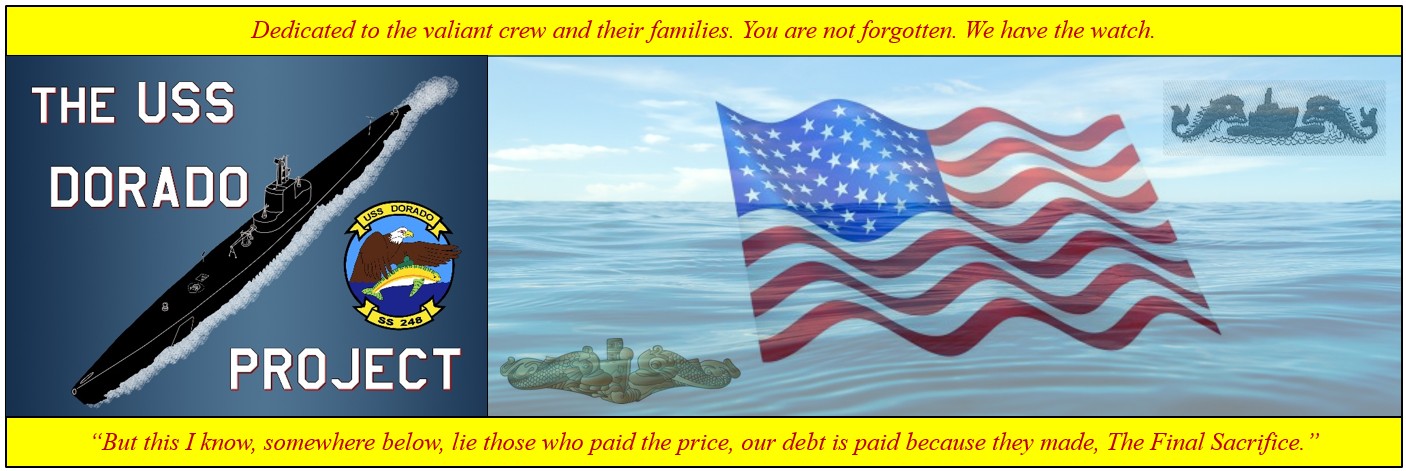Dorado Crew: Difference between revisions
Pbcjohnston (talk | contribs) mNo edit summary |
Pbcjohnston (talk | contribs) Added content to page |
||
| Line 9: | Line 9: | ||
</center></span> | </center></span> | ||
<center>[[File:Subs bottom line 2.jpg]] | <center>[[File:Subs bottom line 2.jpg]]</center><br><br> | ||
[[File:Dorado crew 1943.jpg|left|thumb|400px|Dorado's crew at Polly's Inn, Montville, CT., August 13, 1943.]] | |||
<div style="text-align: justify;"><span style="color:#00008B">If you were to catch a sailor in one of those rare wistful and reflective moments, that sailor may tell you that a ship has a soul, a personality and energy all of its own. There may be something to that, but at the end of the day a ship, even a highly sophisticated one like a submarine, is just a collection of mechanical devices contained within a steel tube. It can't move on its own or fight on its own, it needs a crew to be truly alive. The crew IS the boat's soul, it provides it with its heartbeat and will, and its ability to carry out the mission it was built for. | |||
The crew is lead by its officers, college educated men that provide the boat with its direction and resolve. At the top is the Commanding Officer (aka CO or Skipper), a seasoned veteran and experienced man of the sea, a man who knows the "art" of submarining down to its core. During WWII the CO could be a senior Lieutenant (LT), but was most often a Lieutenant Commander (LCDR) or Commander (CDR). By 1943 the CO of a fleet submarine had risen up through the officer ranks, having served on several submarines previously, and had likely also had surface ship experience. He would be intelligent and driven, capable of multi-tasking on a high level. He would be capable of solving complex mathematical calculations quickly in his head, all the while managing a complex fighting machine in a calm and decisive manner.<br><br> | |||
<div style="text-align: justify;"><span style="color:#000000"> | <div style="text-align: justify;"><span style="color:#000000"> | ||
<div style="text-align: justify;"><span style="color:#00008B"> | [[File:Earle Caffrey Schneider.jpg|right|thumb|150px|LCDR E.C. Schneider, USN]] | ||
<div style="text-align: justify;"><span style="color:#00008B">For the Dorado that man was LCDR Earle Caffrey Schneider. A native of Beaufort, North Carolina, Schneider had the Navy in his blood. | |||
<center>[[File:RWB Starbar ver 3.jpg|300px]]</center> | <center>[[File:RWB Starbar ver 3.jpg|300px]]</center> | ||
Revision as of 13:12, 26 June 2025

| Main Page | Latest News & Updates | The Submarine | The Crew | Photographs | The Loss Scenario | The Aircraft | Case for the Purple Heart | The Myths | Research Documents |

The crew is lead by its officers, college educated men that provide the boat with its direction and resolve. At the top is the Commanding Officer (aka CO or Skipper), a seasoned veteran and experienced man of the sea, a man who knows the "art" of submarining down to its core. During WWII the CO could be a senior Lieutenant (LT), but was most often a Lieutenant Commander (LCDR) or Commander (CDR). By 1943 the CO of a fleet submarine had risen up through the officer ranks, having served on several submarines previously, and had likely also had surface ship experience. He would be intelligent and driven, capable of multi-tasking on a high level. He would be capable of solving complex mathematical calculations quickly in his head, all the while managing a complex fighting machine in a calm and decisive manner.

Page created by:
Thaddeus Weaver & David Johnston
©2025 - Thaddeus Weaver & PigBoats.COM
West Warwick, RI, Norfolk, VA
ussdoradoproject@gmail.com